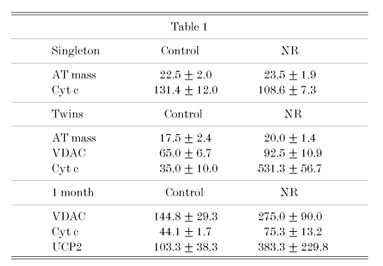Maternal nutrient restriction over the final month of gestation restricts fetal adipose tissue (AT) deposition (Symonds et al. 1998) but effects on mitochondrial protein abundance have not been examined. In newborn lambs, birth is associated with a rapid increase in a range of mitochondrial proteins including uncoupling protein (UCP)1, voltage-dependent anion channel (VDAC) and cytochrome (cyt) c (Mostyn et al. 2001). Over the first month of life as UCP1 disappears, UCP2 becomes the dominant UCP in adipose tissue. The present study examined the extent to which abundance of these primary mitochondrial proteins are influenced by either maternal nutrition and/or fetal number.
Twenty-seven primiparous pregnant Border Leicester X Swaledale ewes were entered into the study. Eight singleton-bearing and six twin-bearing ewes were fed and consumed 100 % of total metabolisable energy (ME) requirements (taking into account requirements for both ewe maintenance and growth of the conceptus in order to produce a 4.5 kg lamb at term) for that stage of gestation whilst the remaining five singleton and eight twin-bearing sets of ewes were nutrient restricted (NR) and consumed 60 % of total ME requirements. The diet comprised chopped hay and concentrate and was fed in a 3:1 weight ratio. All ewes lambed normally at term when all singleton lambs were killed with an overdose of barbiturate (100 mg kg-1 pentobarbital sodium: Euthatal) within 6 h of birth to enable perirenal adipose tissue sampling. One twin from each ewe was treated similarly. The remaining twins were reared with their ewe until 28 days after birth when perirenal adipose tissue was sampled after killing. These experiments were carried out in accordance with UK legislation. Mitochondria were prepared and analysed using immunoblotting with antibodies specific for cyt c, VDAC and UCP2 that produced single bands at 16, 35 and 32 kDa, respectively. Results (means ± S.E.M.) are expressed as a percentage of a reference sample present on all gels. Significant differences with respect to maternal nutrition and fetal number were assessed by analysis of variance.
As shown in Table 1, maternal NR resulted in an increased abundance of both cyt c (P < 0.001) and VDAC (P = 0.06) in perirenal adipose tissue of twins but not singletons. This was despite maternal nutrition having no effect on either lamb body or adipose tissue weights, although both were lower (P < 0.05) in twins compared with singletons. By 1 month of age, although there was no difference in body or adipose tissue weights between groups; lambs born to NR ewes possessed adipose tissue with a higher abundance of VDAC, cyt c and UCP2.
In conclusion, mitochondrial development in fetal adipose tissue can be reprogrammed by maternal nutrient restriction in late gestation. This effect is dependent on fetal number and may contribute to altered adipose tissue function in later life.
This work was supported by a University of Nottingham Hospital Research and Development grant.

